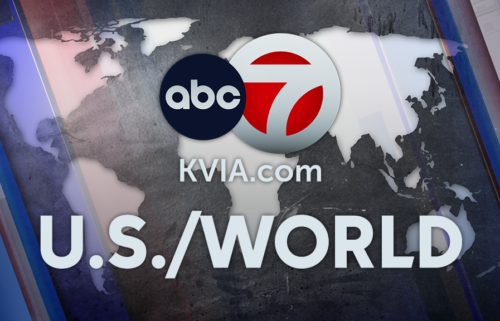COP25 really is the ‘point of no return’ in the climate emergency. Here’s why

It’s a summit that could make or break the world’s climate commitments.
Around 25,000 people from 200 countries are descending on Madrid this week to attend the COP25 climate change conference. They include dozens of heads of state and government, business leaders, scientists and, of course, activists — including Swedish teenager Greta Thunberg.
United Nations Secretary General Antonio Guterres said Sunday that the summit marks the “point of no return” in humanity’s fight against climate change.
Just getting there was tricky. The gathering was originally going to be hosted by Brazil. But the country dropped out under the then-newly elected president Jair Bolsonaro late last year, so the meeting moved to Chile. When violent anti-government protests erupted in Chile in October, the meeting was moved again, this time to the Spanish capital.
What is COP25, anyway?
Remember the Paris Climate Accord? Under the 2015 agreement, more than 200 nations committed to keep global warming to well below 2 degrees Celsius above pre-industrial levels and, if possible, to less than 1.5 degrees above.
The world is now 1.1 degrees warmer than it was at the beginning of the Industrial Revolution — a change that has already had a profound effect on the planet and people’s lives.
COP — officially, the Conference of the Parties to the UN Convention on Climate Change — is the body that makes sure the Paris agreement is implemented. The 25 signifies that this is the group’s 25th meeting.
But there are so many climate change conferences.
Yes, climate change is increasingly on the agenda, because its destructive effects are becoming more visible and impossible to ignore — even by the world’s most powerful people.
Just on Monday, a new report from Oxfam found that one person is forced out of their home every two seconds as a result of climate change.
Guterres said Sunday that “climate change is no longer a long-term problem.”
“We are confronted now with a global climate crisis,” he said. “The point of no return is no longer over the horizon. It is in sight and hurtling towards us.”
That sounds a bit alarmist. Is COP25 really the ‘point of no return’?
Guterres has a point. While scientists have been making the connection between climate change and greenhouse gases for decades, emissions are still going up.
The Madrid meeting is the last gathering of the COP group before 2020, the year when the Paris agreement comes into effect.
When nations signed the deal back in 2015, they agreed that global emissions of greenhouse gases must peak in 2020 at the latest, and then start coming down — or the world will face disastrous and irreversible damage.
Under current scenarios, emissions will need to fall by 7.6% every year in the next decade.
That will require most countries to up their commitments ahead of the next COP meeting in Glasgow next November. According to the UN, if we rely only on the current climate plans, temperatures can be expected to rise by 3.2 degrees this century.
That sounds scary. Can we do anything to stop this?
Yes. But we need to act quickly.
To make meeting the reduction targets even remotely possible, global leaders must come up with a practical plan for cutting emissions in the next two weeks.
Some rules were agreed at the COP24 conference in Poland last year. But that meeting failed to agree the rules for a new international emission-trading system, a crucial part of the plan. That discussion is back on the agenda this year.
Experts say that if the delegates reach a deal on emissions trading, we might just about be able to reach the targets. If they fail, we will definitely trail behind the plan.
That doesn’t mean all is lost — but it does make dealing with the consequences of climate change even more expensive. The later we wait, the more drastic (and pricey) measures will be needed to save the planet.
What is emissions trading?
A global market for carbon dioxide emissions would allow governments and businesses to trade their greenhouse gas output. Those that manage to keep their emissions below a set cap could sell the remaining allowance to those that can’t.
Experts agree that an efficient trading mechanism could make our fight against climate change cheaper and fairer. It would also allow business to play much bigger role — something scientists say is necessary in order to achieve the Paris goals.
But the issue is thorny. A badly designed trading system could lead to double counting, which would make cuts look bigger then they actually are. And a carbon price that is too high or too low could jeopardize the whole idea.
This is not a groundbreaking idea. The European Union set up the world’s first trading system in 2005. It covers the bloc’s most polluting power stations and industrial plants, and airlines. The EU says it works — emissions from the installations covered the system are falling.
Isn’t it all pointless if the US isn’t on board?
There is no doubt that the decision by President Donald Trump to take the United States out of the Paris accord was a major setback to the effort to limit global warming.
The US is responsible for 13% of global emissions, the world’s second biggest emitter after China. If calculated per head, the US is well above anyone else.
But while it may be more difficult to reach the targets without the US — the American absence means the world’s other big polluters will have to step up their commitments. — some global leaders doubled down on the pledge.
Just days after the US withdrew from the Paris agreement, Chinese President Xi Jinping and French President Emmanuel Macron signed a pact recommitting to it.
And even though the US has formally withdrawn, under the framework of the agreement, the withdrawal process cannot be completed until November 4, 2020, which happens to be one day after the 2020 presidential election.
Should Trump lose the 2020 election, a new president could rejoin the agreement.
In that case, the US would have to make new, more ambitious climate commitments to the UN straightaway (something other countries will do gradually in the coming months).
In the meantime, some individual American cities and states have pledged to stick to the agreement.


